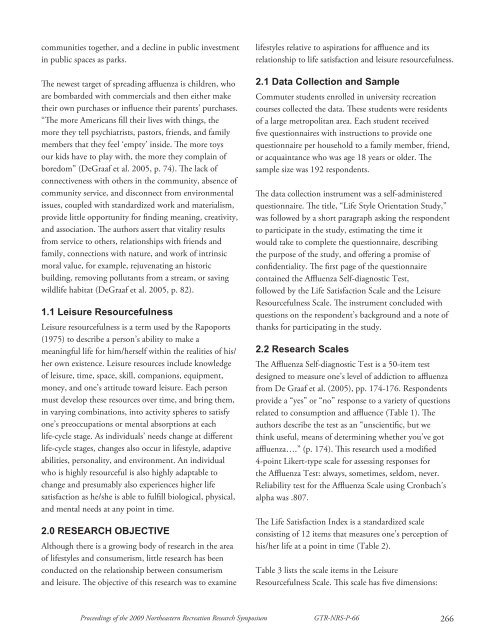Proceedings of the 2009 northeastern recreation research symposium
Proceedings of the 2009 northeastern recreation research symposium
Proceedings of the 2009 northeastern recreation research symposium
You also want an ePaper? Increase the reach of your titles
YUMPU automatically turns print PDFs into web optimized ePapers that Google loves.
communities toge<strong>the</strong>r, and a decline in public investment<br />
in public spaces as parks.<br />
Th e newest target <strong>of</strong> spreading affl uenza is children, who<br />
are bombarded with commercials and <strong>the</strong>n ei<strong>the</strong>r make<br />
<strong>the</strong>ir own purchases or infl uence <strong>the</strong>ir parents’ purchases.<br />
“Th e more Americans fi ll <strong>the</strong>ir lives with things, <strong>the</strong><br />
more <strong>the</strong>y tell psychiatrists, pastors, friends, and family<br />
members that <strong>the</strong>y feel ‘empty’ inside. Th e more toys<br />
our kids have to play with, <strong>the</strong> more <strong>the</strong>y complain <strong>of</strong><br />
boredom” (DeGraaf et al. 2005, p. 74). Th e lack <strong>of</strong><br />
connectiveness with o<strong>the</strong>rs in <strong>the</strong> community, absence <strong>of</strong><br />
community service, and disconnect from environmental<br />
issues, coupled with standardized work and materialism,<br />
provide little opportunity for fi nding meaning, creativity,<br />
and association. Th e authors assert that vitality results<br />
from service to o<strong>the</strong>rs, relationships with friends and<br />
family, connections with nature, and work <strong>of</strong> intrinsic<br />
moral value, for example, rejuvenating an historic<br />
building, removing pollutants from a stream, or saving<br />
wildlife habitat (DeGraaf et al. 2005, p. 82).<br />
1.1 Leisure Resourcefulness<br />
Leisure resourcefulness is a term used by <strong>the</strong> Rapoports<br />
(1975) to describe a person’s ability to make a<br />
meaningful life for him/herself within <strong>the</strong> realities <strong>of</strong> his/<br />
her own existence. Leisure resources include knowledge<br />
<strong>of</strong> leisure, time, space, skill, companions, equipment,<br />
money, and one’s attitude toward leisure. Each person<br />
must develop <strong>the</strong>se resources over time, and bring <strong>the</strong>m,<br />
in varying combinations, into activity spheres to satisfy<br />
one’s preoccupations or mental absorptions at each<br />
life-cycle stage. As individuals’ needs change at diff erent<br />
life-cycle stages, changes also occur in lifestyle, adaptive<br />
abilities, personality, and environment. An individual<br />
who is highly resourceful is also highly adaptable to<br />
change and presumably also experiences higher life<br />
satisfaction as he/she is able to fulfi ll biological, physical,<br />
and mental needs at any point in time.<br />
2.0 RESEARCH OBJECTIVE<br />
Although <strong>the</strong>re is a growing body <strong>of</strong> <strong>research</strong> in <strong>the</strong> area<br />
<strong>of</strong> lifestyles and consumerism, little <strong>research</strong> has been<br />
conducted on <strong>the</strong> relationship between consumerism<br />
and leisure. Th e objective <strong>of</strong> this <strong>research</strong> was to examine<br />
lifestyles relative to aspirations for affl uence and its<br />
relationship to life satisfaction and leisure resourcefulness.<br />
2.1 Data Collection and Sample<br />
Commuter students enrolled in university <strong>recreation</strong><br />
courses collected <strong>the</strong> data. Th ese students were residents<br />
<strong>of</strong> a large metropolitan area. Each student received<br />
fi ve questionnaires with instructions to provide one<br />
questionnaire per household to a family member, friend,<br />
or acquaintance who was age 18 years or older. Th e<br />
sample size was 192 respondents.<br />
Th e data collection instrument was a self-administered<br />
questionnaire. Th e title, “Life Style Orientation Study,”<br />
was followed by a short paragraph asking <strong>the</strong> respondent<br />
to participate in <strong>the</strong> study, estimating <strong>the</strong> time it<br />
would take to complete <strong>the</strong> questionnaire, describing<br />
<strong>the</strong> purpose <strong>of</strong> <strong>the</strong> study, and <strong>of</strong>f ering a promise <strong>of</strong><br />
confi dentiality. Th e fi rst page <strong>of</strong> <strong>the</strong> questionnaire<br />
contained <strong>the</strong> Affl uenza Self-diagnostic Test,<br />
followed by <strong>the</strong> Life Satisfaction Scale and <strong>the</strong> Leisure<br />
Resourcefulness Scale. Th e instrument concluded with<br />
questions on <strong>the</strong> respondent’s background and a note <strong>of</strong><br />
thanks for participating in <strong>the</strong> study.<br />
2.2 Research Scales<br />
Th e Affl uenza Self-diagnostic Test is a 50-item test<br />
designed to measure one’s level <strong>of</strong> addiction to affl uenza<br />
from De Graaf et al. (2005), pp. 174-176. Respondents<br />
provide a “yes” or “no” response to a variety <strong>of</strong> questions<br />
related to consumption and affl uence (Table 1). Th e<br />
authors describe <strong>the</strong> test as an “unscientifi c, but we<br />
think useful, means <strong>of</strong> determining whe<strong>the</strong>r you’ve got<br />
affl uenza….” (p. 174). Th is <strong>research</strong> used a modifi ed<br />
4-point Likert-type scale for assessing responses for<br />
<strong>the</strong> Affl uenza Test: always, sometimes, seldom, never.<br />
Reliability test for <strong>the</strong> Affl uenza Scale using Cronbach’s<br />
alpha was .807.<br />
Th e Life Satisfaction Index is a standardized scale<br />
consisting <strong>of</strong> 12 items that measures one’s perception <strong>of</strong><br />
his/her life at a point in time (Table 2).<br />
Table 3 lists <strong>the</strong> scale items in <strong>the</strong> Leisure<br />
Resourcefulness Scale. Th is scale has fi ve dimensions:<br />
<strong>Proceedings</strong> <strong>of</strong> <strong>the</strong> <strong>2009</strong> Nor<strong>the</strong>astern Recreation Research Symposium GTR-NRS-P-66<br />
266
















